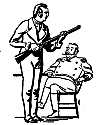|
Whitney's
plan was to build a set of special tools with which to
make each part of the gun. These parts were to be very accurate and -
as Whitney put it - they were to be "as much alike as the successive
impressions of a copperplate engraving." By using this system, he would
duplicate each piece of the very best gun available.
 By the end of the first year he had produced only 500 acceptable
guns. His contract called for 4,000 - and he was still designing
machinery. The War Department and Congress became very impatient, so
Whitney packed up the parts of ten guns - triggers, barrels, stocks,
etc.- and went to Washington. On arriving at the Capitol, he placed a
table in the conference room and on it he laid piles of each one of
these parts. He asked the officials to take a part from each pile. Then
he proceeded to assemble a perfect gun from them. With that
demonstration, mass production passed its second test.
By the end of the first year he had produced only 500 acceptable
guns. His contract called for 4,000 - and he was still designing
machinery. The War Department and Congress became very impatient, so
Whitney packed up the parts of ten guns - triggers, barrels, stocks,
etc.- and went to Washington. On arriving at the Capitol, he placed a
table in the conference room and on it he laid piles of each one of
these parts. He asked the officials to take a part from each pile. Then
he proceeded to assemble a perfect gun from them. With that
demonstration, mass production passed its second test.Almost 100 years later, the automobile was born - a machine of thousands of parts which must be fitted together as accurately as the parts of a gun. The first automobiles were nearly all hand-built, and in those early days "hand-made" was a mark of excellence. Many people thought foreign workmanship superior to American, and would not buy an automobile unless it had been made abroad. It was this challenge to our industrial ingenuity that brought about the third step in the story of mass production. |








